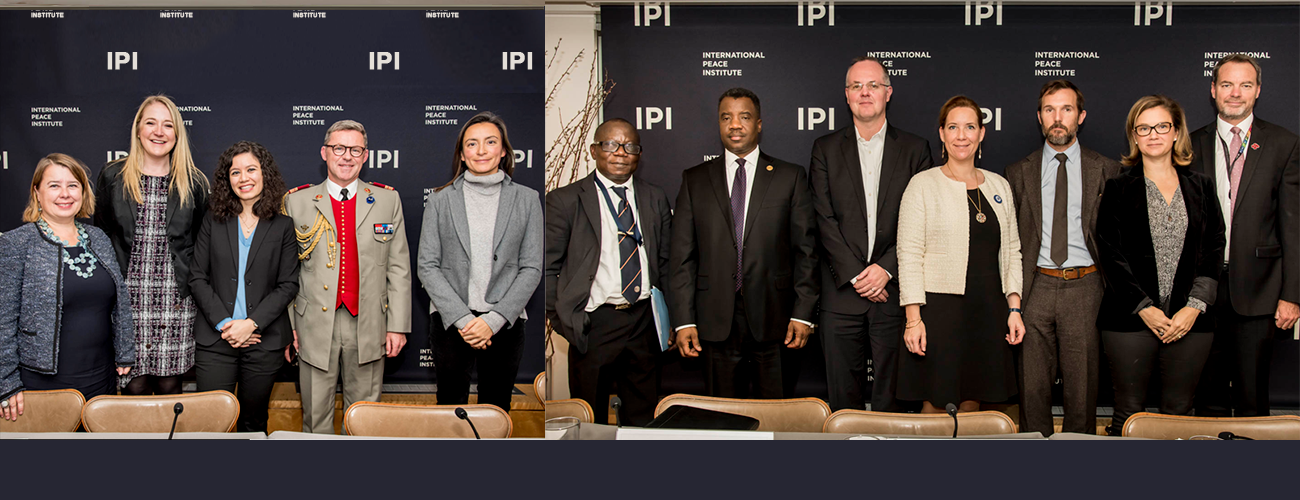United Nations peace operations often operate in complex theaters where a wide array of actors are also deployed by specific member states or regional organizations to effectively address peace and security challenges, and on November 4th, IPI and the French Ministry of Armed Forces held a policy forum to explore peacekeeping partnerships.
The event featured two panel discussions and launched two IPI publications, Partners and Competitors: Forces Operating in Parallel to UN Peace Operations by IPI Senior Fellow Alexandra Novosseloff and Lisa Sharland, Head of the International Program of the Australian Strategic Policy Institute (ASPI), and Lessons for “Partnership Peacekeeping” from the African Union Mission in Somalia (AMISOM) by Paul D. Williams, Professor at the Elliott School of International Affairs at the George Washington University.
Jake Sherman, Director of IPI’s Brian Urquhart Center for Peace Operations, opened the morning-long discussion by noting that six UN operations are now fielded in partnerships with regional, subregional, and other non-UN forces, and he suggested this pattern presaged upcoming deployments. “Regional and subregional bodies are increasingly authorized by the UN Security Council to take on roles for which the UN peacekeeping forces are ill-suited,” he said. “Parallel forces will be an essential aspect of planning and deploying all UN peacekeeping in the future.”
Laure Bansept of France’s Ministry of the Armies said there had been around 40 such coalition deployments since the end of the Cold War and that they were “helpful in situations where the UN lacks the capacity or skills to work in certain sensitive contexts” and allowed the UN to “focus on its mandates.” Referencing France’s support for African-led peace operations, she said these partnerships proved essential “when humanitarian situations rapidly deteriorate and threaten the stability of a region, and no other organization can address it as immediately.”
IPI Research Fellow Namie Di Razza said that regional organizations “offer what UN peace operations don’t have—they have different entry points and different resources and capacities.” Citing her experience researching the case of Mali, she warned, however, that while all actors pursue the same objective in different ways, they also risk “confusion, conflation with peacekeeping operations, and duplication.” She suggested there should be “a clear division between forces.”
Ms. Sharland listed three “rationales” for deploying parallel forces:
- Where there is a humanitarian imperative, and immediate action is necessary, they can respond more rapidly and robustly than a UN force.
- Since parallel forces can be more advanced militarily, they can overcome reservations about the capability of UN peace operations.
- They can serve national interests and intervene to protect their own nationals.
She also listed four “classifications” of parallel forces: military stabilization, crisis response, insurance or deterrence, and capacity building, and three different types of actors: bilateral, multinational, and regional organizations. “No two parallel forces are the same,” she said, “so while we can draw some broad lessons, we must be conscious of each unique context.”
Her co-author, Dr. Novosseloff, addressed some of the challenges these parallel force partnerships pose. “UN and parallel forces may have different motivations and goals, and this impacts the way they work on the ground and also their effectiveness,” she said. “The lack of mutual understanding and communication at the strategic level can be more damaging than we think. The divisions of labor that should be at the heart of the deployments are not clear enough.”
She said that central to these concerns was “the impartiality of UN peace operations and how partners can work with non-UN forces that may have different objectives. It impacts the perception of local populations so the impartiality of the UN will be at stake.” Such a lack of distinction, she said, could be exploited by “those seeking to undermine the peace or the process by going after the UN.” And potential mission overlap raised the danger of UN forces being “dragged into situations for which they are not equipped.” Airing these objections, Dr. Novosseloff said, should not be seen as minimizing the positive elements of parallel deployments, “such as additional niche capacities, military robustness, and political support. But the various stakeholders have to make stronger efforts to make them less of competitors and more genuine partners.”
The report makes a series of specific recommendations, but in general, Dr. Nosovoleff concluded, it represented a “plea for a stronger cooperation between all stakeholders involved in crisis management because all the money spent comes from the same pockets, and there needs to be a greater accountability.”
Col. Richard Decombe, Defense Mission of the Permanent Mission of France to the UN, said that while there remained room for improvement in how parallel forces operate, “it’s already an achievement.” Detailing the work of the Multidimensional Integrated Stabilization Mission in Mali (MINUSMA), he explained how a coordinating forum involving five different partners (MINUSMA, Barkhane, G5 Sahel Joint Force, Malian Armed Forces, and EU training mission) met every two months. “What is in place is quite good, in terms of coordination and communication so the partners are at least informed on what the others are doing,” he said. What they can do better, he said, was having a stronger focus on building up the capacity of local security forces.
Naomi Miyashita, Senior Political Affairs Officer, UN Department of Peace Operations, said that parallel forces were of great value to the UN, which typically confronts situations with a dense web of competing regional and international interests and no clear path to a comprehensive political solution. “Parallel operations shape the space that others have for alternative approaches,” she said.
Self-criticism was essential, she added. “We must be constantly asking ourselves what the progression of the conflict has been and be constantly critically evaluating whether our interventions are having the desired effect and whether stability in itself is a good enough long term objective. We need to be clear about where we add value and where we have strength and comparative advantage. For the UN, it’s its political role, support for political processes and ability to protect civilians.”
The second panel of the morning provided an opportunity to discuss Paul D. William’s IPI report on Lessons for “Partnership Peacekeeping” from the African Union Mission in Somalia (AMISOM). The report describes AMISOM as the AU’s “longest, largest, most expensive and deadliest” peace operation and says that for the UN it is “the most profound experiment not only with providing logistical support in a war zone, but also with partnering on the political front.” Dr. Williams described AMISOM as “probably the most complicated model for any modern peace operation we’ve ever seen,” a model, he said, that “evolved in response to a series of crises and in an ad hoc manner.” As a consequence, he said, the AMISOM model is “not one that screams out for replication, but there are a lot positive things we can draw from it.”
Since AMISOM reflected “the primacy of politics”, the fraught state of politics in Somalia, a country with no state authority for decades, has prevented the mission from becoming effective, he said. “AMISOM has been unable to deliver a peace dividend because the Somali government did not come in behind it and support it.”
In Dr. Williams’ account, AMISOM was less nimble than its principle adversary, the Islamist militant group al-Shabab, and the conflict became “cat and mouse”, with the government regularly “displacing” al-Shabab but “not destroying its capabilities.” The result was starkly counter-productive, he said. “Extending state authority and consolidating it in a place where the central government is not universally accepted as legitimate is not peacebuilding, it’s actually conflict-provoking.”
AMISOM has also failed to stabilize the polarized society, attract local support, shape an exit strategy, or design what kind of government structure it should leave behind, he said. “At a fundamental level, there are real limits to what a peace operation can achieve when the local actors do not want to see the issue reconciled and resolved. Until the parties in Somalia reconcile, AMISOM will be stuck holding the line and not generating the means for its successful exit.”
Rick Martin, Director of the Division for Special Activities in the UN Department of Operational Support, acknowledged that the situation in which AMISOM is working is “very complex.” But he said there were lessons to be learned, principally that “a partnership of the sort we have in Somalia needs to start at the strategic level—it has to be built on planning, as a contingency for further cooperation, and focus on building capacities between the two organizations. ”He agreed with Dr. Williams that the AMISOM model should not be replicated but conceded that “something similar is likely to evolve again in the future.”
Alhaji Sarjoh Bah, Chief Advisor on Peace, Security, and Governance, AU Permanent Mission to the UN, said that the UN mission in Somalia compared favorably to the UN mission in Afghanistan. It illustrated, he said, the particular challenges that Africa presented. “The AU talks about peace operations, not peacekeeping. Peacekeeping is driven by consent, impartiality, but our peace operations range from peacekeeping to open warfare and counter insurgency. When we went into Somalia, there was a clearly identifiable enemy, so in the views of al-Shabab, we were ‘legitimate targets.’ We haven’t been deterred by the absence of peace to keep. We have gone in, created peace, and then maintained the peace, as in Somalia and Liberia.”
Among the lessons he said were learned from the mission in Somalia were that from the outset, there has to be a “political strategy” and “planning” for a subsequent “multi-dimensional phase,” and neighboring states must be “involved and committed.”
Chloé Marnay-Baszanger, Chief of the Peace Mission Section of the Office of the UN High Commissioner for Human Rights (UNHCR), said that “we are witnessing a reconfiguration of how the international community responds to conflict, and Somalia has been a good example of how to think through our processes. If the UN is not the primary vehicle for leading international intervention, then how can we make sure that human rights are still a priority in crisis response?”
She said that Somalia presented a distinct problem because there was no Protection of Civilians (POC) mandate to AMISOM. In its absence, she said, “what we managed to do through the human rights due diligence policy, we managed to strike a conversation about how we reduce the likeliness of violence against civilians in the context of complex violence.” She said that the most important lesson that the Somalia and the G5 Sahel experiences taught was “going forward, we put mechanisms in place so that from the beginning, we don’t have to course-correct.”
Dr. Di Razza moderated the first discussion on parallel forces, and Mr. Sherman the second on lessons from AMISOM.








